Are pie charts evil? An assessment of the value of pie and donut charts compared to bar charts
IF 1.8
4区 计算机科学
Q3 COMPUTER SCIENCE, SOFTWARE ENGINEERING
引用次数: 0
Abstract
Many data visualization experts recommend the use of bar charts over pie charts because they consider comparing the area or angle of segments to be less accurate than comparing bars on a bar chart. However, many studies show that when the pie chart is used to estimate proportions (arguably its main function) it is as accurate as the bar chart. A major issue is that most previous studies have only looked at one method of extracting information from pie charts, for example either by comparing the segment to the circle (the part-whole relationship) or one segment to another (relative magnitude estimation). Therefore, in this study I test multiple metrics to provide a more holistic assessment of the pie and donut chart against the bar chart. I also measured cognitive load through pupillometry. In summary, bar charts were more precise than pie and donut charts for ranking elements, but all charts were equally accurate for extracting the part-whole relationship. There was little difference in cognitive load between chart types, although bar charts were consistently faster to use on average. Overall, the bar chart was more flexible, but where there were statistically significant differences between charts, the effect sizes were often small, and unlikely to prevent effective extraction of quantitative information. That is, as long as they were used appropriately, all chart types were arguably acceptable for displaying simple, categorical data.饼图邪恶吗?饼图和甜甜圈图与条形图相比的价值评估
许多数据可视化专家建议使用柱形图而不是饼图,因为他们认为比较线段的面积或角度不如比较柱形图上的条形图准确。然而,许多研究表明,当饼状图用于估计比例时(可以说是其主要功能),其准确性不亚于条形图。一个主要的问题是,以前的大多数研究都只研究了从饼图中提取信息的一种方法,例如,要么是通过比较分段与圆圈(部分与整体的关系),要么是通过比较一个分段与另一个分段(相对大小估计)。因此,在本研究中,我测试了多个指标,以便对饼状图和甜甜圈图与条形图进行更全面的评估。我还通过瞳孔测量法测量了认知负荷。总之,条形图比饼状图和甜甜圈图在元素排序方面更精确,但所有图表在提取部分与整体的关系方面同样精确。虽然条形图的平均使用速度更快,但不同类型图表之间的认知负荷差别不大。总体而言,条形图更灵活,但如果图表之间存在统计学意义上的显著差异,其影响大小往往很小,不太可能妨碍有效提取定量信息。也就是说,只要使用得当,所有图表类型都可以用来显示简单的分类数据。
本文章由计算机程序翻译,如有差异,请以英文原文为准。
求助全文
约1分钟内获得全文
求助全文
来源期刊

Information Visualization
COMPUTER SCIENCE, SOFTWARE ENGINEERING-
CiteScore
5.40
自引率
0.00%
发文量
16
审稿时长
>12 weeks
期刊介绍:
Information Visualization is essential reading for researchers and practitioners of information visualization and is of interest to computer scientists and data analysts working on related specialisms. This journal is an international, peer-reviewed journal publishing articles on fundamental research and applications of information visualization. The journal acts as a dedicated forum for the theories, methodologies, techniques and evaluations of information visualization and its applications.
The journal is a core vehicle for developing a generic research agenda for the field by identifying and developing the unique and significant aspects of information visualization. Emphasis is placed on interdisciplinary material and on the close connection between theory and practice.
This journal is a member of the Committee on Publication Ethics (COPE).
 求助内容:
求助内容: 应助结果提醒方式:
应助结果提醒方式:


